Taipei 101
| Taipei 101 | |
|---|---|
| 台北101 / 臺北101 | |
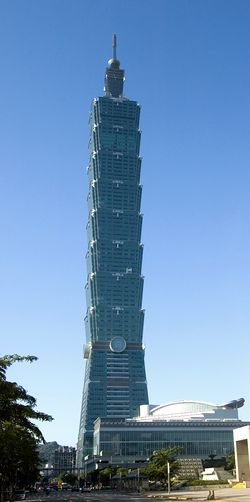 |
|
|
Taipei 101 was the world's tallest building from 2004 to 2010.[I] |
|
| Record height | |
| Preceded by | Petronas Towers |
| Surpassed by | Burj Khalifa |
| General information | |
| Location | Xinyi District, Taipei, Taiwan |
| Status | Complete |
| Constructed | 1999-2004 |
| Use | Mixed use: communication, conference, fitness center, library, observation, office, restaurant, retail |
| Height | |
| Antenna or spire | 509.2 m (1,670.6 ft) |
| Roof | 449.2 m (1,473.8 ft) |
| Top floor | 439.2 m (1,440.9 ft) |
| Technical details | |
| Floor count | 101 |
| Floor area | 412,500 m2 (4,440,100 sq ft) |
| Elevators | 61 Toshiba/KONE elevators, including double-deck shuttles and 2 high speed observatory elevators) |
| Cost | NT$ 58 billion (USD $ 1.80 billion)[1] |
| Companies involved | |
| Architect(s) | C.Y. Lee & partners |
| Structural engineer | Thornton Tomasetti |
| Contractor | Samsung C&T, KTRT Joint Venture |
| Owner | Taipei Financial Center Corporation |
| Management | Urban Retail Properties Co. |
|
^ Fully habitable, self-supported, from main entrance to highest structural or architectural top; see the list of tallest buildings in the world for other listings. |
|
Taipei 101 (traditional Chinese: 台北101 / 臺北101), also known as the Taipei Financial Center, is a landmark skyscraper located in Xinyi District, Taipei, Taiwan. The building ranked officially as the world's tallest from 2004 until the opening of the Burj Khalifa in Dubai in 2010. Taipei 101, designed by C.Y. Lee & partners and constructed primarily by KTRT Joint Venture and numerous subcontractors including Samsung C&T[2] received the 2004 Emporis Skyscraper Award. The tower has served as an icon of modern Taiwan ever since its opening. Fireworks launched from Taipei 101 feature prominently in international New Year's Eve broadcasts and the structure appears frequently in travel literature and international media.
Taipei 101 comprises 101 floors above ground and 5 floors underground. The name of the tower reflects its floor count. The building was architecturally created as a symbol of the evolution of technology and Asian tradition (see "Symbolism" below.) Its postmodernist approach to style incorporates traditional design elements and gives them modern treatments. The tower is designed to withstand typhoons and earthquakes. A multi-level shopping mall adjoins the tower houses to hundreds of fashionable stores, restaurants and clubs.
Taipei 101 is owned by the Taipei Financial Center Corporation (TFCC) and managed by the International division of Urban Retail Properties Corporation based in Chicago. The name originally planned for the building, Taipei World Financial Center (until 2003), was derived from the name of the owner. The original name in Chinese was literally, Taipei International Financial Center (traditional Chinese: 臺北國際金融中心; pinyin: Táiběi Guójì Jīnróng Zhōngxīn).
In 2010, Taipei officials proposed a plan that would expand on the Taipei 101 to add five additional floors. This will bring the building to 106 floors total by 2012. Several versions of the plans exist, including digging additional basement floors or removing and redesigning the top of the skyscraper. No approvals have been made to the plan yet. The building, however, will still retain the name Taipei 101 based on this plan as this was its original name, and as a tribute to the building in its original form.
Contents |
Features
Height
The Taipei 101 tower comprises 101 stories above ground and five underground. Upon its completion Taipei 101 claimed the official records for:
- Ground to highest architectural structure (spire): 509.2 metres (1,671 ft). Previously held by the Petronas Towers 452 m (1,483 ft).
- Ground to roof: 449.2 m (1,474 ft). Formerly held by the Willis Tower 442 m (1,450 ft).
- Ground to highest occupied floor: 439.2 m (1,441 ft). Formerly held by the Willis Tower 412.4 m (1,353 ft).
- Fastest ascending elevator speed: 16.83 m/s (55.22 ft/s) (60.6 km/h, 37.7 mi/h). Now it has been succeeded by Burj Khalifa's elevator whose speed of ascending is 18m/s (64 km/h).
- Largest countdown clock: Displayed on New Year's Eve.
- Tallest sundial. (See 'Symbolism' below.)
Taipei 101 was the first building in the world to break the half-kilometer mark in height[3] and the first record-setting skyscraper constructed in the new millennium.
The record it claimed for greatest height from ground to pinnacle now rests with the Burj Khalifa in Dubai (UAE): 828 m (2,717 ft). Taipei 101's records for roof height and highest occupied floor briefly passed to the Shanghai World Financial Center in 2009, which in turn yielded these records as well to the Burj.
Taipei 101 displaced the Petronas Towers in Kuala Lumpur, Malaysia, as the tallest building in the world by 57.2 m (188 ft).[4] It also displaced the 85-story, 347.5 m (1,140 ft) Tuntex Sky Tower in Kaohsiung as the tallest building in Taiwan and the 51-story, 244.2 m (801 ft) Shin Kong Life Tower as the tallest building in Taipei.[5]
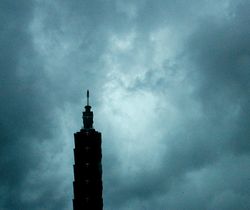
Various sources, including the building's owners, give the height of Taipei 101 as 508.0 m (1,667 ft), roof height and top floor height as 448.0 m (1,470 ft) and 438.0 m (1,437 ft). This lower figure is derived by measuring from the top of a 1.2 m (4 ft) platform at the base. CTBUH standards, though, include the height of the platform in calculating the overall height, as it represents part of the man-made structure and is above the level of the surrounding pavement.[6][7]
Construction
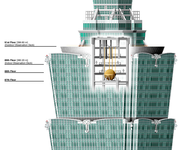
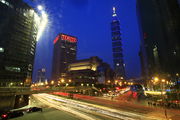
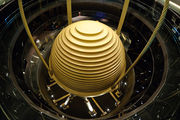
Taipei 101 is designed to withstand the typhoon winds and earthquake tremors common in its area of the Asia-Pacific. Planners aimed for a structure that could withstand gale winds of 60 m/s (197 ft/s, 216 km/h, 134 mph) and the strongest earthquakes likely to occur in a 2,500 year cycle.[8]
Skyscrapers must be flexible in strong winds yet remain rigid enough to prevent large sideways movement (lateral drift). Flexibility prevents structural damage while resistance ensures comfort for the occupants and protection of glass, curtain walls and other features. Most designs achieve the necessary strength by enlarging critical structural elements such as bracing. The extraordinary height of Taipei 101 combined with the demands of its environment called for additional innovations. The design achieves both strength and flexibility for the tower through the use of high-performance steel construction. Thirty-six columns support Taipei 101, including eight "mega-columns" packed with 10,000-psi concrete.[9] Every eight floors, outrigger trusses connect the columns in the building's core to those on the exterior.
These features combine with the solidity of its foundation to make Taipei 101 one of the most stable buildings ever constructed. The foundation is reinforced by 380 piles driven 80 m (262 ft) into the ground, extending as far as 30 m (98 ft) into the bedrock. Each pile is 1.5 m (5 ft) in diameter and can bear a load of 1,000 metric tons (1,100 short tons) - 1,320 metric tons (1,460 short tons).[9] The stability of the design became evident during construction when, on March 31, 2002, a 6.8-magnitude earthquake rocked Taipei. The tremor was strong enough to topple two construction cranes from the 56th floor, then the highest. Five people died in the accident, but an inspection showed no structural damage to the building, and construction soon resumed.
Thornton-Tomasetti Engineers along with Evergreen Consulting Engineering designed a 660 metric tons (728 short tons)[10] steel pendulum that serves as a tuned mass damper, at a cost of NT$132 million (US$4 million).[11] Suspended from the 92nd to the 88th floor, the pendulum sways to offset movements in the building caused by strong gusts. Its sphere, the largest damper sphere in the world, consists of 41 circular steel plates, each with a height of 125 mm (4.92 in) being welded together to form a 5.5 m (18 ft) diameter sphere.[12] Another two tuned mass dampers, each weighing 6 metric tons (7 short tons),[11] sit at the tip of the spire. These prevent damage to the structure due to strong wind loads.
Taipei 101's characteristic blue-green glass curtain walls are double paned and glazed, offer heat and UV protection sufficient to block external heat by 50 percent, and can sustain impacts of 7 metric tons (8 short tons).[8] Recycled water meets 20-30 percent of the building's water needs. Upgrades are currently under way to make Taipei 101 "the world's tallest green building" by LEED standards by summer 2011.[13]
Symbolism
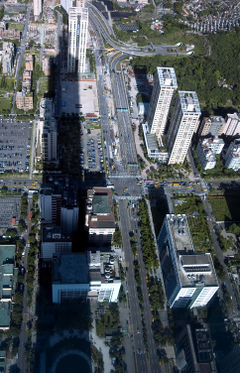
Taipei 101, like all spire structures, participates in the symbolism of a world center where earth and sky meet and the four compass directions join.
The height of 101 floors commemorates the renewal of time: the new century that arrived as the tower was built (100+1) and all the new years that follow (January 1 = 1-01). It symbolizes high ideals by going one better on 100, a traditional number of perfection. The number also evokes the binary numeral system used in digital technology.[9]
The main tower features a series of eight segments of eight floors each. In Chinese-speaking cultures the number eight is associated with abundance, prosperity and good fortune. In cultures that observe a seven-day week the number eight symbolizes a renewal of time (7+1). In cultures where seven is the lucky number, 8 represents 1 better than 'lucky seven'. In digital technology the number eight is associated with the byte, being 8 bits. A bit is the basic (minimal) unit of information.
The repeated segments simultaneously recall the rhythms of an Asian pagoda (a tower linking earth and sky, also evoked in the Petronas Towers), a stalk of bamboo (an icon of learning and growth), and a stack of ancient Chinese ingots or money boxes (a symbol of abundance). The four discs mounted on each face of the building where the pedestal meets the tower represent coins. The emblem placed over entrances shows three gold coins of ancient design with central holes shaped to imply the Arabic numerals 1-0-1.[9]
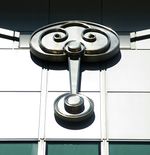
Curled ruyi figures appear throughout the structure as a design motif. The ruyi is an ancient symbol associated with heavenly clouds. It connotes healing, protection and fulfilment. It appears in celebrations of the attainment of new career heights.[14] Each ruyi ornament on the exterior of the Taipei 101 tower stands at least 8 m (26 ft) tall. The sweeping curved roof of the adjoining mall culminates in a colossal ruyi that shades pedestrians. Though the shape of each ruyi at Taipei 101 is traditional, its metallic interpretation is plainly modern.
At night the bright yellow gleam from its pinnacle casts Taipei 101 in the role of a candle or torch upholding the ideals of liberty and welcome. From 6:00 to 10:00 each evening[15] the tower's lights display one of seven colours in the spectrum. The colours coincide with the days of the week:
| Day | Monday | Tuesday | Wednesday | Thursday | Friday | Saturday | Sunday |
|---|---|---|---|---|---|---|---|
| Colour | Red | Orange | Yellow | Green | Blue | Indigo | Violet |
The cycle through the spectrum connects the tower with the rich symbolism of rainbows as bridges linking earth to sky and earth's peoples to one another.
Millennium Park adjoins Taipei 101 on the east and connects the landmark further with the symbolism of time. The design of the circular park allows it to double as the face of a sundial. The tower itself casts the shadow to indicate afternoon hours for the building's occupants. The park's design is echoed in a clock that stands at its entrance. The clock runs on energy drawn from the building's wind shear.
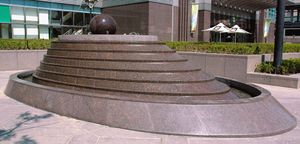
Taipei 101, like many of its neighbours, shows the influence of feng shui philosophy. An example appears in the form of a large granite fountain at the intersection of Songlian Road and Xinyi Road near the tower's east entrance.[16] A ball at the fountain's top spins toward the tower. As a work of public art, the fountain offers a contrast to the tower in texture even as its design echoes the tower's rhythms. Yet the fountain also serves a practical function in feng shui philosophy. A T intersection near the entrance of a building represents a potential drain of positive energy, or ch'i, from a structure and its occupants. Flowing water placed at such spots remedy the situation by generating a positive inward flow of ch'i. The fountain applies a traditional solution to a traditional challenge yet its design remains modern.
Taipei 101 merges ancient motifs and ideas with modern techniques and materials. As a landmark it renews the symbolism of all tall towers as cosmic centers. Its interplaying symbols speak of optimism, abundance, and the ever-renewing cycles of time.
Interior

Taipei 101 is the first record-setting skyscraper to be constructed in the twenty-first century. Appropriately it exhibits a number of technologically advanced features as it provides a center for business and recreation.
The original 2004 fiber-optic and satellite Internet connections permitted transfer speeds up to a gigabyte per second.
The double-deck elevators built by the Japanese Toshiba Elevator and Building Systems Corporation (TELC) set a new record in 2004 with top ascending speeds of 16.83 m (55.22 ft) per second (60.6 km/h, 37.7 mi/h). This speed is 34.7 percent faster than the previous record holders of the Yokohama Landmark Tower elevator, Yokohama, Japan, which reaches speeds of 12.5 m (41 ft) per second (45.0 km/h, 28.0 mi/h). Taipei 101's elevators sweep visitors from the fifth floor to the 89th-floor observatory in only 37 seconds.[17] Each elevator features an aerodynamic body, full pressurization, state-of-the art emergency braking systems, and the world's first triple-stage anti-overshooting system. The cost for each elevator is NT$80 million (US$2.4 million).[18][19][20][21]
A 660-metric-ton (728 short ton) tuned mass damper stabilizes the tower against movements caused by high winds. The damper can reduce up to 40% of the tower's movements (see "Construction").
The observatories are located in the 91st and 89th floors. (See "Observatories" below.)
Two restaurants have opened on the 85th floor: Diamond Tony's, which offers European-style seafood and steak, and Shin Yeh 101 (欣葉), which offers Taiwanese-style cuisine. Occupying all of the 86th floor is Japanese restaurant XEX.[22]
The multi-story retail mall adjoining the tower is home to hundreds of fashionable stores, restaurants, clubs and other attractions. The mall's interior is modern in design even as it makes use of traditional elements. The curled ruyi symbol is a recurring motif inside the mall. Many features of the interior also observe feng shui traditions.
Observatories
Taipei 101 features an Indoor Observatory (89th floor) and an Outdoor Observatory (91st floor).[23] Both offer 360-degree views and attract visitors from around the world.
The Indoor Observatory stands 383.4 m (1,258 ft) above ground, offering a comfortable environment, large windows with UV protection, recorded voice tours in eight languages, and informative displays and special exhibits. Here one may view the skyscraper's main damper, nicknamed "Damper Baby", and buy food, drinks and gift items.
Two more flights of stairs take visitors up to the Outdoor Observatory. The Outdoor Observatory, at 391.8 m (1,285 ft) above ground, is the second-highest observation deck ever provided in a skyscraper and the highest such platform in Taiwan.
The Indoor Observatory is open twelve hours a day (10:00 am–10:00 pm) throughout the week as well as on special occasions; the Outdoor Observatory is open during the same hours as weather permits. Tickets may be purchased on site in the shopping mall (5th floor) or in advance through the Observatory's web site.[24] Tickets cost NT$400 (US$13) and allow access to the 88th through 91st floors via high-speed elevator.[25]
Art
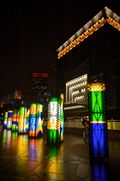
Many works of art appear in and around Taipei 101. These include:[9]
- Rebecca Horn (Germany). Dialogue between Yin and Yang. 2002. Steel, iron.
- Robert Indiana (USA). Love and 1-0. 2002. Aluminum.
- Ariel Moscovici (France). Between Earth and Sky. 2002. Rose de la claret granite.
- Chung Pu (Taiwan). Global Circle. 2002. Black granite, white marble.
- Jill Watson (Britain). City Composition. 2002. Bronze.
The Indoor Observatory hosts a regular series of exhibitions. The artists represented have included Wu Ching (gold sculpture), Ping-huang Chang (traditional painting) and Po-lin Chi (aerial photography).[26]
Tenants
A number of enterprises maintain offices in Taipei 101. A few that have been featured in public announcements[26] include these:
- ABN AMRO Bank, 1/F
- Anthony's Group Holding Company Ltd, 37/F
- Bayer Taiwan, 53/F - 54/F
- The Boston Consulting Group, 61/F
- Cosmos Bank, 5th Floor
- DBS Bank Ltd, 28/F, Unit B
- Emirates Advocates Taiwan (Emirates Trade Commission)
- The Executive Centre, 37/F
- Fulland Securities Consultant Company Ltd (a Hantec Group subsidiary), 24/F
- GoldBank of Taiwan
- Google Taiwan, 73/F
- HVB Bank
- ING Antai
- ING SITE (affiliate of Internationale Nederlanden Groep N.V., or ING)
- ING SCE (affiliate of Internationale Nederlanden Groep N.V., or ING)
- Jones Lang LaSalle
- KPMG
- L'Oréal Taiwan[27]
- McKinsey & Company Taiwan
- PeopleSearch Taiwan
- People's King
- SABIC Asia Pacific Pte Ltd
- Starbucks Coffee
- Taiwan Ratings Corporation
- Taiwan Stock Exchange Corporation (TSEC)
- Winterthur Life Taiwan
Restaurants in the tower include XEX, Diamond Tony's and Shin Yeh 101 (欣葉).[22] Hundreds of international dining establishments and retail outlets also operate in the adjoining mall.
Construction Chronology
Important dates in the planning and construction of Taipei 101 include the following:[9]
| Date | Event |
|---|---|
| October 20, 1997 | Development and operation rights agreement signed with Taipei City government. |
| January 13, 1998 | Ground-breaking ceremony. |
| June 7, 2000 | First tower column erected. |
| April 13?, 2001 | Design change to 509.2 m height approved by Taipei City government. |
| June 13, 2001 | Taipei 101 Mall topped out. |
| August 10, 2001 | Construction license awarded for 101 stories. |
| May 13, 2003 | Taipei 101 Mall obtains occupancy permit. |
| July 1, 2003 | Taipei 101 Tower roof completed. |
| October 17, 2003 | Pinnacle placed. |
| November 14, 2003 | Taipei 101 Mall opens. |
| April 15, 2004 | Council on Tall Buildings and Urban Habitat (CTBUH) certifies Taipei 101 as world's tallest building. |
| November 12, 2004 | Tower obtains occupancy permit. |
| December 31, 2004 | Tower opens to the public. |
| January 1, 2005 | First New Year fireworks show begins at midnight. |
History
Construction
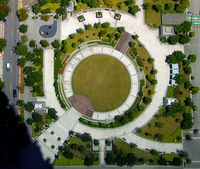
Planning for Taipei 101 began in 1997 during Chen Shui-bian's term as Taipei mayor. Talks between merchants and city government officials initially centered on a proposal for a 66-story tower to serve as an anchor for new development in Taipei's 101 business district. Planners were considering taking the new structure to a more ambitious height only after an expat suggested it, along with many of the other features used in the design of the building. It wasn't until the summer of 2001 that the city granted a license for the construction of a 101-story tower on the site. In the meantime, construction proceeded and the first tower column was erected in the summer of 2000.
Taipei 101's roof was completed three years later on July 1, 2003. Ma Ying-jeou, in his first term as Taipei mayor, fastened a golden bolt to signify the achievement.
The formal opening of the tower took place on New Year's Eve 2004. President Chen Shui-bian, Taipei Mayor Ma Ying-jeou and Legislative Speaker Wang Jin-pyng cut the ribbon. Open-air concerts featured a number of popular performers, including singers A-Mei and Sun Yan Zi. Visitors rode the elevators to the Observatory for the first time. A few hours later the first fireworks show at Taipei 101 heralded the arrival of a new year.[29] [30]
Modifications
The Taipei Financial Center Corporation (TFCC) announced plans on 2009 November 2 to make Taipei 101 "the world's tallest green building" by summer of 2011 as measured by LEED standards. The structure is already designed to be energy-efficient, with double-pane windows blocking external heat by 50% and recycled water meeting 20-30% of the building's needs. (LEED) certification would entail inspections and upgrades in wiring, water and lighting equipment at a cost of NT$60 million (US$1.8 million). Estimates show the savings resulting from the modifications would pay for the cost of making them within three years.[13][28]
Events
Taipei 101 is the site of innumerable special events. Art exhibits, as noted above, regularly take place in the Observatory. A few noteworthy dates since the tower's opening include these.
- December 25, 2004 - French rock and urban climber Alain Robert makes an authorized climb to the top of the pinnacle in four hours.[29]
- February 28, 2005 - Former President of the United States Bill Clinton visits and signs copies of his autobiography.[26]
- April 19, 2005 - Tower displays the formula E=mc2 in lights to celebrate the 100th anniversary of the publication of Einstein's theory of relativity. The display, the largest of 65,000 such displays in 47 countries, is part of the international celebration Physics Enlightens the World.[26]
- November 20, 2005 - First annual Taipei 101 Run Up features a race up the 2,046 steps from floors 1 to 91. Proceeds benefit Taiwan's Olympic teams. Men's race is won by Paul Crake of Australia (10 minutes, 29 seconds) and women's race by Andrea Mayr of Austria (12 minutes, 38 seconds).[26]
- October 20, 2006 - Tower displays a pink ribbon in lights to promote breast cancer awareness. The ten-day campaign is sponsored by Taipei 101's ownership and Estée Lauder.[26]
- December 12, 2007 - Austrian base jumper Felix Baumgartner survives an unauthorized parachute jump from Taipei 101's 91st floor.[30]
- June 15, 2008 - Taipei 101 Run Up features 2,500 participants. Men's race is won by Thomas Dold of Germany (10 minutes, 53 seconds); 2007 champion Marco De Gasperi of Italy finishes second and Chen Fu-tsai of Taiwan finishes third. Women's race is won by Lee Hsiao-yu of Taiwan (14 minutes, 53 seconds).[31][32]
New Year's Eve fireworks displays
For the first three years (2004–2006), the annual fireworks show at Taipei 101 was preceded by the sequential display of numerals in lights on each section to count down the last eight seconds to midnight. Since 2007 the building has been completely darkened, then fireworks begin to launch sequentially from the lower to upper sections.
- 2003–2004: Building still under construction. Spinning lights on the Outdoor Observatory (floor 91) provided a display of sound and lights, but no fireworks were launched.
- 2004–2005: Grand opening of Taipei 101 celebrated with the first fireworks display. The show lasted 35 seconds. Rockets were launched from section balconies. Festivities included all-day performances by popular entertainers and ceremonial visits by national dignitaries.
- 2005–2006: Show extended to 128 seconds. Sony sponsored the show, which concluded with a display of the brand name in lights.
- 2006–2007: Show extended to 188 seconds; 9,000 rockets were launched. Sony was again the sponsor.
- 2007–2008: Show same length but featuring 12,000 rockets. Civic and private sponsors ended the show with a display, in lights, of a heart over the word 'Taiwan.'
- 2008–2009: A conspicuously more modest show than those which preceded it. The theme was "Love Taiwan With Your Heart In 2009". The show ended with the four sides of the building displaying lights in four colours (red, blue, green and yellow) to represent happiness, vision, sustainability and passion.
- 2009-2010: The display regained some of the dazzle of 2005-2008 shows but remained more brief in duration. The theme was "Taiwan Up."
Floor Directory
| 92nd - 101st floor |
Communication Floors |
|---|---|
| 91st floor |
Observation Deck |
| 88th - 89th floor |
Observatory |
| 85th - 86th floor |
Observatory Restaurant |
| 59th - 84th floor |
High Zone Office Floor |
| 59th - 60th floor |
Elevator Transfer Floors |
| 35th - 58th floor |
Mid Zone Office Floor |
| 36th floor |
Taipei 101 Conference Center |
| 35th - 36th floor |
Elevator Transfer Floors |
| 35th floor |
Amenities Floor |
| 9th - 34th floor |
Low Zone Office Center |
| B1 - 6 (Basement - 6th floor) |
Taipei 101 Shopping Mall |
| 1st - 2nd floor |
Grand Lobby |
| B2 - B5 (2nd Basement - 5th Basement floor) |
Basement Car Parking |
Gallery
 Taipei 101, cosmic pillar |
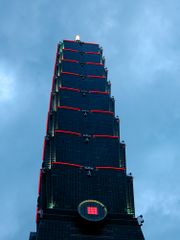 Taipei 101 at dusk (Monday) |
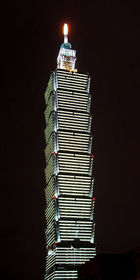 Taipei 101 at night, fully lit (rare) |
Night view of Taipei 101 from Xiangshan Peak, Xinyi District |
 Taipei 101 from Taipei City Hall |
 Taipei 101, Christmas lighting in December 2005 |
 E=mc2 lighting on April 19, 2005 |
 Taipei 101 seen from Sun Yat Sen Memorial Hall |
 Taipei 101 New Year's fireworks, 2008 |
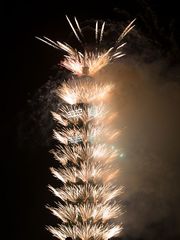 Taipei 101 New Year's fireworks, 2008 |
 Taipei 101 New Year's fireworks, 2008 |
 Taipei 101 New Year's fireworks, 2009 |
 Taipei 101 New Year's fireworks, 2010 |
 Taipei 101 Entrance |
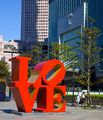 Love at Taipei 101 |
 Taipei 101 view from street level |
See also
- Taipei
- Shin Kong Life Tower
- Tuntex Sky Tower
- Burj Khalifa
- Petronas Towers
- Skyscraper
- List of skyscrapers
- List of tallest buildings and structures in the world
- List of tallest freestanding structures in the world
- List of buildings with 100 floors or more
- Skyscraper Index
References
- ↑ My E Gov, The E-government Entry Point of Taiwan - Taiwan Yearbook 2005, Wikipedia - List of world's most expensive single objects
- ↑ The building of the Taipei 101 skyscraper
- ↑ Emporis - Taipei 101
- ↑ "Taiwan tops out tallest building". BBC News. October 17, 2003. http://news.bbc.co.uk/1/hi/world/asia-pacific/3200160.stm. Retrieved May 24, 2010.
- ↑ SkyscraperPage - List of skyscrapers in Taiwan
- ↑ CTBUH - Criteria for Defining and Measuring Tall Buildings
- ↑ USAToday - Taipei skyscraper deemed tallest, Paragraph abstract: The council measures from the sidewalk level of the main entrance to the skyscraper's architectural top.
- ↑ 8.0 8.1 Observatory brochure, Floor 89, Taipei 101. 2007-08-17.
- ↑ 9.0 9.1 9.2 9.3 9.4 9.5 Publicly posted material, Floor 89, Taipei 101. 2007-08-17.
- ↑ Taipei 101 Official Website - Observatory Servicing Facilities
- ↑ 11.0 11.1 Taipei 101 Official Website - Tuned Mass Damper
- ↑ "Motioneering - Taipei 101" (PDF). Motioneering. http://www.rwdi.com/cms/publications/81/pp_Taipei101.pdf.
- ↑ 13.0 13.1 http://www.etaiwannews.com/etn/news_content.php?id=1147437&lang=eng_news
- ↑ http://www.fengshuibestbuy.com/ruyi1.html Feng Shui Bestbuy - Ru Yi
- ↑ Taipei 101 Official Website - Lights Schedule
- ↑ "Taipei 101, Bigger is not Better (台北101, 更大不等於更好)". Taiwan Design Center. 2004.09.15. http://www.taiwandesign.com.tw/NewsDetail.aspx?bid=B20070117002453. Retrieved 2009-09-17.
- ↑ Taipei 101 Official Website - Observatory Floor Guide
- ↑ Taipei 101 Official Website - Facts about Taipei 101
- ↑ Popular Mechanics - World's Fastest Elevator
- ↑ ArchitectureWeek - Taiwan On Top
- ↑ Elevator World - Breaking the 1000MPM Barrier - High speed elevators in Taipei 101
- ↑ 22.0 22.1 Taipei 101 Official Website - 85F Restaurant
- ↑ Taipei Times - Shin Kong Tower Observatory to close by year-end
- ↑ Taipei 101 Official Website - Floor Guide
- ↑ Taipei 101 Official Website - Observatory Visit Information
- ↑ 26.0 26.1 26.2 26.3 26.4 26.5 Taipei 101 Official Website -101季刊 eNewsletter
- ↑ "Taiwan." L'Oréal. Retrieved on July 14, 2010.
- ↑ http://www.etaiwannews.com/etn/news_content.php?id=1097555&lang=eng_news&cate_img=49.jpg&cate_rss=news_Society_TAIWAN&mbn=E2DC4446A6B7C6A8667D23030B8E04F7
- ↑ BBC News - 'Spiderman' scales tallest tower", 2005-12-25.
- ↑ "Base jumper survives leap off worlds tallest building". The Times (London). December 13, 2007. http://www.timesonline.co.uk/tol/news/world/asia/article3043109.ece. Retrieved May 24, 2010.
- ↑ Afp - German wins race up world's tallest skyscraper
- ↑ Inquirer - German wins race up world's tallest skyscraper
External links
- Taipei 101 Official Website
- Taipei 101 Official Website - Observatory
- Taipei 101 Official Website - Mall
- YouTube - Taipei 101 New Year Fireworks 2005, 2006, 2007, 2008
- National Geographic Channel - Richard Hammond examines Taipei 101
- Taipei 101 at Structurae
- Consulting services by RWDI (wind engineering and emergency ventilation) and Motioneering (tuned mass damper)
- Megastructure Supports Taipei’s 508-Meter ‘Megatower’ by Engineering News-Record, a weekly magazine by McGraw-Hill Construction of McGraw-Hill
- LEED Official Site
- C. Y. Lee Architects Office Official Website
| Preceded by Sears Tower |
World's tallest building rooftop 449.2 m (1473.75 ft) 2003–2008 |
Succeeded by Shanghai World Financial Center |
| Preceded by Petronas Towers |
World's tallest building architectural element 509.2 m (1670.60 ft) 2003–2007 |
Succeeded by Burj Khalifa |
| Preceded by 30 St Mary Axe (London, England) |
Emporis Skyscraper Award (Gold) 2004 |
Succeeded by Turning Torso (Malmö, Sweden) |
|
||||||||||||||||||||||||||||||||||||||||||||||||||||||||||||||